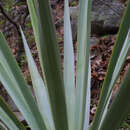Comments
provided by eFloras
Yucca madrensis is closely related to Y. jaliscensis to the south and the Y. schottii complex to the north. We follow L. W. Lenz and M. A. Hanson (2000b), who have determined that plants with long, wide, flexible, blue leaves that are now usually identified as Y. schottii Engelmann (not congruent with Engelmann’s original description) are more correctly referred to Y. madrensis. Lenz and Hanson further suggested that what is now called Y. schottii represents a hybrid complex among Y. baccata, Y. elata, and Y. madrensis. This putative hybridization is conjectural, and without firm evidence we are uncertain as to the appropriate disposition of the name Y. schottii. We are somewhat skeptical of the potential for crosses between baccate species (Y. baccata and Y. madrensis) and capsular species (Y. elata).
- license
- cc-by-nc-sa-3.0
- copyright
- Missouri Botanical Garden, 4344 Shaw Boulevard, St. Louis, MO, 63110 USA
Description
provided by eFloras
Plants solitary, caulescent, shorter than 3 m. Stems 1, simple, unbranched, shorter than 2 m. Leaf blade erect to reflexing with age, bluish-glaucous or green to yellow-green, thin, flat to conduplicate, flexible, margins entire or occasionally filiferous with slender fibers, brown to grayish, smooth. Inflorescences erect, paniculate, somewhat open, arising 1/4–1/2 within rosettes, elongate-ovoid, to 8 dm, sparsely pubescent. Flowers pendent, 3.5 cm; perianth ovoid; tepals distinct, or barely connate basally, white, ovate-lanceolate to lanceolate, ca. 3 × 1.4 cm; filaments ca. 1.5 cm, glabrous; pistil 1.5–4 cm; ovary ca. 2.5 cm. Fruits becoming pendent, baccate, indehiscent, 6–12.5 × 2.5–3.8 cm, fleshy, succulent. Seeds gray, 7–10 mm diam., 5–8 mm thick.
- license
- cc-by-nc-sa-3.0
- copyright
- Missouri Botanical Garden, 4344 Shaw Boulevard, St. Louis, MO, 63110 USA
Distribution
provided by eFloras
Ariz.; Mexico (Chihuahua, Sonora).
- license
- cc-by-nc-sa-3.0
- copyright
- Missouri Botanical Garden, 4344 Shaw Boulevard, St. Louis, MO, 63110 USA
Flowering/Fruiting
provided by eFloras
Flowering in summer with rains.
- license
- cc-by-nc-sa-3.0
- copyright
- Missouri Botanical Garden, 4344 Shaw Boulevard, St. Louis, MO, 63110 USA
Habitat
provided by eFloras
Madrean pine-oak forest; 1400--1600m.
- license
- cc-by-nc-sa-3.0
- copyright
- Missouri Botanical Garden, 4344 Shaw Boulevard, St. Louis, MO, 63110 USA
Yucca madrensis: Brief Summary
provided by wikipedia EN
Yucca madrensis H. S. Gentry is a plant in the genus Yucca in the family Asparagaceae. It is native to a mountainous region in the Sierra Madre Occidental in the Mexican states of Sonora and Chihuahua. It has also been reported from Arizona It grows on steep, rocky slopes in pine-oak forests.
Yucca madrensis has indehiscent fruits and serrate leaves. This suggests relationships with Y. rigida Trel. and Y. schottii Engelm. It differs from both those species by several characters such as narrowness of the leaves, glabrous inflorescence, and short stature.
- license
- cc-by-sa-3.0
- copyright
- Wikipedia authors and editors

